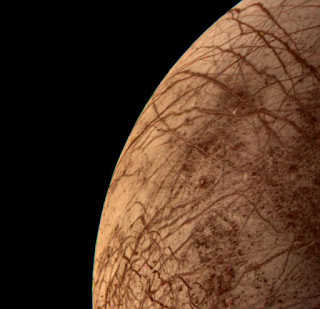Nuclear Tunnelbot For Space Exploration
Nuclear Powered Robots for the Moon Europa
Proposed to Explore One of Jupiter's Moons for Signs of Life
A group of scientists who advise and solve problems for NASA have come up with a unique proposal. They want to deploy a tunnelbot that would use nuclear power to melt a path through one of Jupiter's frozen moons. The moon is called Europa and it's the 4th largest of Jupiter's 53 moons. It's considered a great place in the solar system to host life.
Powered by Nuclear Reactor or NASA's Radioactive Heat Bricks
The scientists unveiled their proposal to the American Geophysical Union. They said the tunnelbot could use an advanced nuclear reactor or some of NASA's radioactive heat bricks to generate heat and power. The robot would carry a payload to search for evidence of life, extant or extinct. The researchers believe Europa's ice hides open oceans and that life may exist there. The robot would go down to a depth of 9 miles and relay back samples of water and ice.
Theoretical Plan
This is a theoretical proposal. It's not clear how they would land the tunnelbot onto Europa. But it demonstrates what future space explorations for signs of life might entail. For more stores on innovation and discovery, go to amazon.com/author/ekane
 |
| Source: NASA photo of Europa |
Proposed to Explore One of Jupiter's Moons for Signs of Life
A group of scientists who advise and solve problems for NASA have come up with a unique proposal. They want to deploy a tunnelbot that would use nuclear power to melt a path through one of Jupiter's frozen moons. The moon is called Europa and it's the 4th largest of Jupiter's 53 moons. It's considered a great place in the solar system to host life.
Powered by Nuclear Reactor or NASA's Radioactive Heat Bricks
The scientists unveiled their proposal to the American Geophysical Union. They said the tunnelbot could use an advanced nuclear reactor or some of NASA's radioactive heat bricks to generate heat and power. The robot would carry a payload to search for evidence of life, extant or extinct. The researchers believe Europa's ice hides open oceans and that life may exist there. The robot would go down to a depth of 9 miles and relay back samples of water and ice.
Theoretical Plan
This is a theoretical proposal. It's not clear how they would land the tunnelbot onto Europa. But it demonstrates what future space explorations for signs of life might entail. For more stores on innovation and discovery, go to amazon.com/author/ekane
%20(1)%20(1)%20(3)%20(2)%20(2).jpg)


Comments
Post a Comment